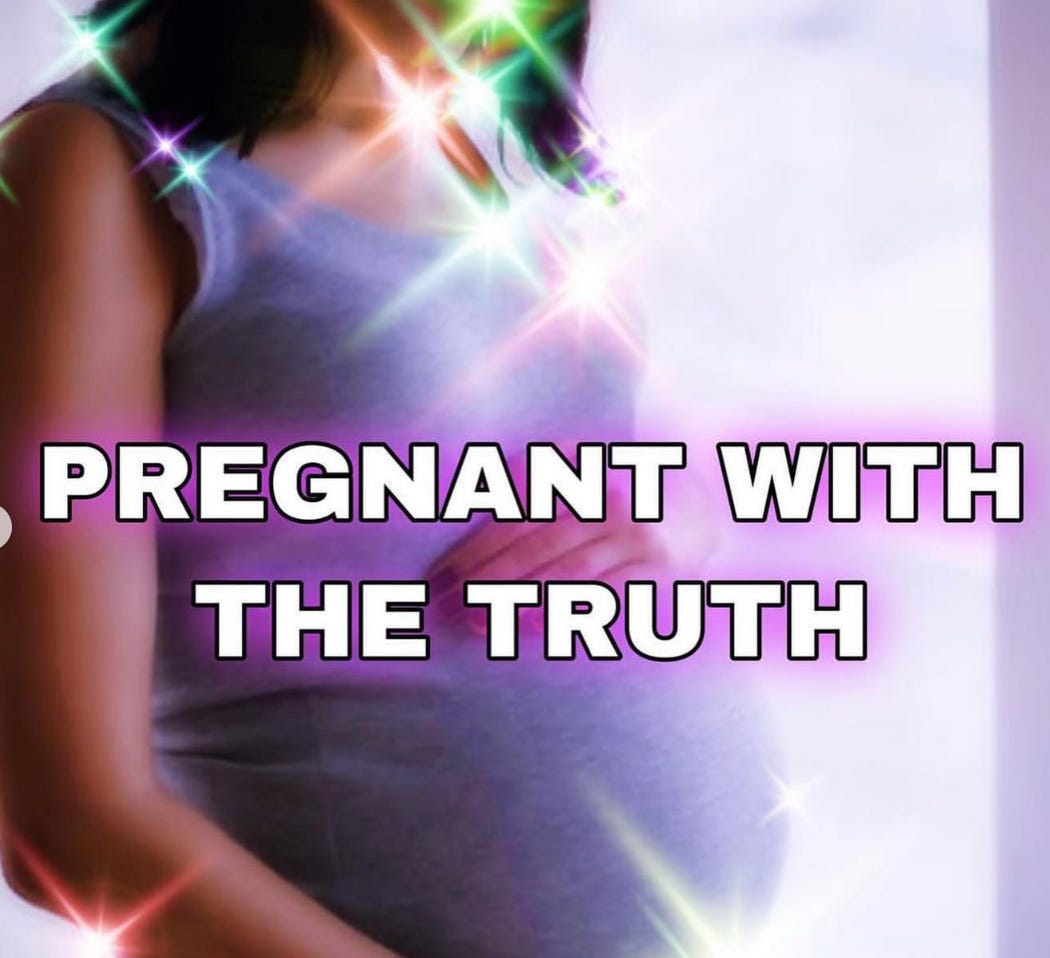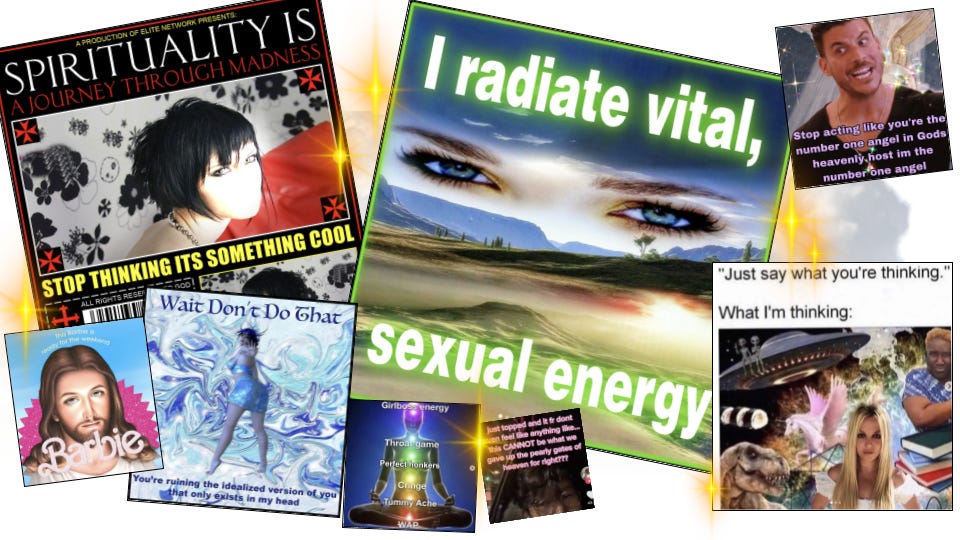022 - Are we all spiritual now?
Young people are reimagining faith for a modern world. But what does that mean? And can brands have any part to play?
Are the memes on your feed more existential than ever? Have you noticed a religious flavour to the style inspo you’re being served? When was the last time you heard someone explain their personality via starsign (“classic Gemini”)? Or say “you manifested it”?
There’s a Big Shift afoot, one that is seeing Gen Z turn to spirituality and religion as a way to make sense of their place in the world, and rewriting what it means for the modern day. But what exactly does this new approach look like? What the hell does it mean for culture? And brands? You better read on…
Back in 2020, I wrote a report about ‘Witchtok’, a surge of Gen Zers identifying as witches and sharing their practices online. At the time, the trend made plenty of sense: Millennials had been eschewing organised religion for a long time, but now, faced with a climate crisis, a pandemic and a nightmarish political landscape, Gen Z needed to find something to believe in. For young (mostly) women around the world, witchcraft, tarot, astrology and the like presented a much needed faith and practice that aligned with their values.
But, like cottagecore (the first of an avalanche of new TikTok aesthetics), this Covid-era internet trend was only the tip of the iceberg. 2020 was the same year Vox reported that searches for ‘manifestation’ had risen by 669% in just 3 months, while Vice and i-D each published pieces about the growing use of alternative religion, like manifestations and tarot readings, online. The Times wrote a piece titled ‘Teenagers turn to God during pandemic’, with YouGov data showing Gen Z were more likely to believe in God than their millennial counterparts. Meanwhile, one US study found that over half of young people experienced a spiritual growth during the pandemic, with 33% believing that lockdown directly improved their religious activities. The iceberg, in this case, was a mass generational and cultural shift towards religion and spirituality that continues to gather pace.
Millennials and Gen Xers in the West have been shifting away from traditional religion and towards alternative practices for years. But Gen Z are carving out a new approach, one that is more holistic. It’s defined by a focus on mental wellbeing and - true to our appetite for information - a curiosity in many belief systems.
A survey of 10,000 Gen Zers in the US found rising rates of faith, in tandem with falling rates of organised religious practice. As they put it: “Even those who are highly religious or spiritual don’t necessarily identify with a particular tradition or institution”. Instead, Gen Z are experiencing faith as a fluid, but increasingly important thing, characterised by an openmindess and ability to access information about religion and spirituality online.
3 years on, and this shift has made it mainstream. #SpiritualTikTok has 7.7 billion views. Someone’s “energy” is no longer just about how tired they are. Astrology is increasingly referenced in pop music (Doja Cat and The Weeknd’s video for You Right being a prime example) and in fashion, too.
And it’s not just the mainstreaming of alternative practices, It’s a rise in faith and faith-adjacent language and iconography across the board. While curious social media users are learning about the religious beliefs and practices of different cultures, both modern or ancient, many young people are taking this a step further, using religion and spirituality as a way to navigate a difficult political climate.
Take the super trendy set of New Yorkers (namely the controversial hosts of social commentary podcasts Red Scare and Wet Brain) who are embracing Catholicism as a reaction to the ‘woke’ mindset that has dominated the liberal left in recent years, framing traditional Catholic family values as a provocative trend with a subversive, apolitical stance (the NYT headline ‘New York's Hottest Club Is the Catholic Church’ says it all).
Or the countless new-gen meme accounts that use spiritual language and iconography as a way to navigate the existential struggle of modern life, and as a young person trying to find your place in it. Take the viral @affirmations, who has leveraged a desperate desire to find fortune and meaning through faith (manifestation included), to lead a tongue-in-cheek ‘Global Self Hyponosis’ movement. Or @ineedgodineverymomentofmylife, the cult account that satirises their own reliance on God.
Many of these fall into a new school of Uber-femme, Uber-existential meme accounts, that has spawned the re-emergence of the Spiritual Bimbo, a 90s cultural trope coined by Nymphet Alumni, now reincarnated in philosophical, empowered and ironic girls and gays. Others feature similar philosophical and religious themes, but in darker tones, or extra deep fried, speaking to a broader emergence of spirituality online - recently coined “nu-spiritiualism” by Dazed.
It’s internet-native musicians like Drain Gang, who soundtrack their audience as they navigate online and IRL, who are propelling and shaping what spirituality means to the new generation. “We believe you can create your own spiritual relationship, and you don’t necessarily have to follow any school of thought or religion or philosophy”, says Ecco2k, holding a mirror up to the many young people that feel the same.
Drain Gang (which also includes Swedish rappers Bladee, Thaiboy Digital and Whitearmour) have built complex lore and mythology around their art, and use spirituality in their music as a way to tackle difficult themes, helping them to help make sense of the world and their place in it. It’s an approach that originally attracted the incel community, but has now earnt a loyal audience of LGBTQIA young people, keen to build an alternative spiritual home for themselves where many organised religions don’t offer one.
Do brands have any part to play in this?
It’s complicated, naturally. Brands can, and do, contribute to the culture. See: Praying, which successfully tapped into sex via subversion with its viral blasphemic bikini, or Mowalola who recently did the same with her cross-shaped-crotch hosiery. But they can, more famously, also leech off it. See: the endless social media ads using the phrase “this is your sign” as an insidious shorthand for “spend money on this now”.
Then there’s a grey area. How do you feel about Lucky Saint, which plays with classic tropes from Western food-and-drink advertising (drink this and you’re saintly, eat this and you’re sinful)? How about Palace x New Balance’s new campaign, which references paganism? Or Bella Hadid’s Kin Euphorics, which uses spiritual language and aesthetics throughout? How about Heaven by Marc Jacobs?
As always, it depends on where you’re standing. Lucky Saint’s ads rely on an audience that’s both familiar with Christian tropes, and ready to subvert them. Palace x New Balance’s ad draws on cultish themes, and relies on its audience to be just-familar-enough with paganism to get the joke without seeing it as superficial. Bella Hadid blatantly leverages the trendiness of the spiritual aesthetics for sales, but it lands (pretty hard, tbf) given the nature and purpose of the product. A shift of context, and all of these could fall flat.
Perhaps the most impressive example is Heaven, who has repurposed the concept of heaven as a haven for its audience, creating a brand world that draws on religious understanding without commodifying it. Rather than reducing spiritual meaning, by borrowing from faiths, Heaven, similarly to Drain Gang, instead creates a kind of faith of its own, for its audience to find home in.
So, brands, be smart. Only reference/celebrate/satirise faith if it is genuinely relevant to your brand, product, or campaign. Be clever, be ironic, be subversive or sincere: just make sure it means something. You’re kind of competing with the meaning of life, after all.
That’s all for this week! As always, we’d love to hear your thoughts. And if you want more on this topic, stay tuned, we have a tasty treat brewing…
Editor: Letty Cole








![WATCH] New Doja Cat Featuring The Weeknd, 'You Right' | ENERGY 106 WATCH] New Doja Cat Featuring The Weeknd, 'You Right' | ENERGY 106](https://substackcdn.com/image/fetch/$s_!zfaw!,w_1456,c_limit,f_auto,q_auto:good,fl_progressive:steep/https%3A%2F%2Fsubstack-post-media.s3.amazonaws.com%2Fpublic%2Fimages%2F20422c85-1294-45bd-a948-2d755a25ac96_1269x634.jpeg)


